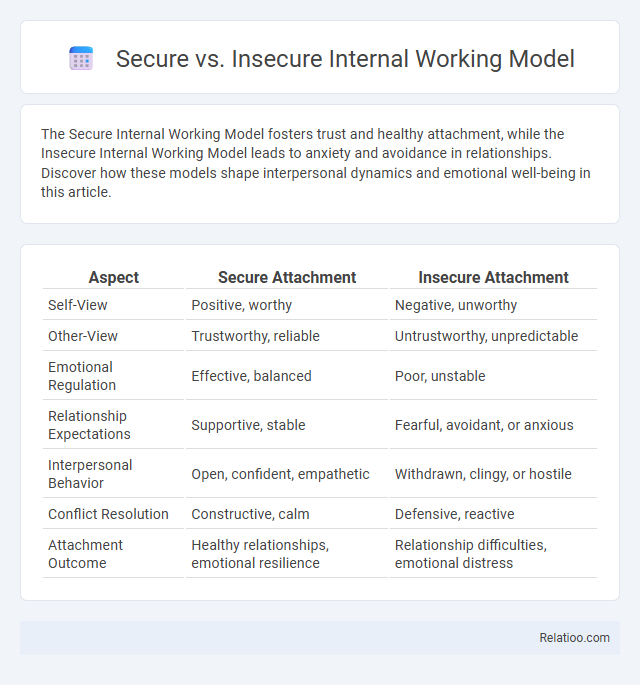The Secure Internal Working Model fosters trust and healthy attachment, while the Insecure Internal Working Model leads to anxiety and avoidance in relationships. Discover how these models shape interpersonal dynamics and emotional well-being in this article.
Table of Comparison
| Aspect | Secure Attachment | Insecure Attachment |
|---|---|---|
| Self-View | Positive, worthy | Negative, unworthy |
| Other-View | Trustworthy, reliable | Untrustworthy, unpredictable |
| Emotional Regulation | Effective, balanced | Poor, unstable |
| Relationship Expectations | Supportive, stable | Fearful, avoidant, or anxious |
| Interpersonal Behavior | Open, confident, empathetic | Withdrawn, clingy, or hostile |
| Conflict Resolution | Constructive, calm | Defensive, reactive |
| Attachment Outcome | Healthy relationships, emotional resilience | Relationship difficulties, emotional distress |
Understanding the Internal Working Model
Understanding the Internal Working Model reveals how early attachment experiences shape your expectations of relationships, influencing emotional regulation and interpersonal behavior. A secure Internal Working Model fosters trust and resilience, while an insecure model often results in anxiety, avoidance, or ambivalence in social connections. Recognizing these patterns allows you to work towards healthier relational frameworks and emotional well-being.
Origins of Secure vs Insecure Internal Working Models
The origins of Secure vs Insecure Internal Working Models stem from early attachment experiences with primary caregivers, which shape Your expectations of relationships and emotional availability. Secure models develop when caregivers are responsive and consistent, fostering trust and emotional resilience, whereas insecure models arise from neglect or inconsistent caregiving, leading to anxiety and avoidance in relationships. These foundational experiences influence how individuals interpret social cues and regulate emotions throughout life.
Key Characteristics of a Secure Internal Working Model
The Secure Internal Working Model is characterized by trust, balanced self-esteem, and healthy interpersonal relationships, enabling individuals to effectively regulate emotions and seek support when needed. It contrasts with the Insecure Internal Working Model, which often involves fear of abandonment, anxiety, or avoidance in attachments, leading to difficulties in emotional regulation and social connections. Key features of a secure model include a positive view of self and others, secure attachment experiences, and adaptive coping strategies that foster resilience and well-being.
Indicators of an Insecure Internal Working Model
Indicators of an insecure internal working model include inconsistent emotional responses, difficulty trusting others, and heightened anxiety in relationships. Individuals with an insecure model may exhibit avoidance, clinginess, or negative self-perceptions rooted in early attachment experiences. These patterns impair effective emotional regulation and relational stability, distinguishing them from those with a secure internal working model.
Impact on Relationships and Attachment Patterns
Secure internal working models foster trust, emotional resilience, and healthy attachment patterns that promote stable and supportive relationships. Insecure internal working models, often characterized by anxiety, avoidance, or ambivalence, can lead to dysfunctional attachment behaviors such as fear of intimacy, dependency, or emotional withdrawal. These attachment patterns significantly influence interpersonal dynamics, relationship satisfaction, and emotional regulation throughout life.
Influence on Emotional Regulation and Self-Perception
Secure Internal Working Models foster effective emotional regulation by promoting trust and positive self-perception, enabling individuals to handle stress and adversity with resilience. Insecure Internal Working Models often lead to emotional dysregulation and negative self-perception, increasing vulnerability to anxiety and depression. These models shape attachment patterns that fundamentally influence how individuals interpret social interactions and manage their emotional responses.
Developmental Factors Shaping Internal Working Models
Developmental factors such as early attachment experiences, caregiver responsiveness, and emotional availability play a crucial role in shaping your internal working models, influencing whether they are secure or insecure. Secure internal working models develop when caregivers consistently provide safety and support, fostering trust and positive expectations in relationships. In contrast, inconsistent or neglectful caregiving leads to insecure models, characterized by anxiety, avoidance, or ambivalence in interpersonal connections.
Long-Term Effects on Mental Health and Wellbeing
Secure internal working models foster resilience by shaping positive self-esteem and trust in relationships, which supports long-term mental health and wellbeing. Insecure internal working models, often formed through inconsistent or neglectful caregiving, increase vulnerability to anxiety, depression, and interpersonal difficulties over time. Your mental health is profoundly influenced by these foundational schemas, highlighting the importance of developing secure attachments early in life for sustained psychological wellness.
Strategies for Shifting from Insecure to Secure Models
Shifting from insecure to secure internal working models involves therapeutic strategies such as consistent emotional attunement, fostering trust through reliable interpersonal interactions, and practicing mindfulness to enhance self-awareness. Techniques like cognitive-behavioral therapy (CBT) and attachment-focused therapy help individuals reframe maladaptive beliefs and build resilience in relationships. Regularly engaging in secure attachment experiences encourages neuroplasticity, enabling the development of healthier mental representations and emotional regulation patterns.
Importance of Secure Internal Working Models in Personal Growth
Secure internal working models form the foundation for healthy emotional development, fostering trust and resilience in personal relationships. These models enable individuals to interpret social cues positively and regulate emotions effectively, which enhances self-esteem and adaptive coping strategies. In contrast, insecure internal working models often lead to maladaptive patterns, hindering personal growth and psychological well-being.

Infographic: Secure vs Insecure Internal Working Model
 relatioo.com
relatioo.com